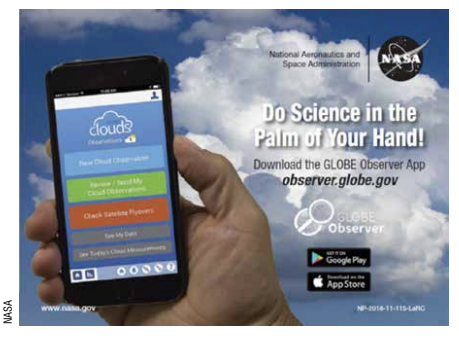GLOBE News
Recent Article: “Making Science Come Alive with Clouds” Offers Tips on Using GLOBE Observer App in the Classroom

A recent article, “Making Science Come Alive with Clouds,” written by Marilé Colón Robles, Jeffrey Bouwman, and Caryn Smith-Long, offers tips on how to use the GLOBE Observer App in the classroom. The article was published in the November/December issue of the National Science Teachers Association (NSTA) Journal.
“The new GLOBE Observer mobile app (GO app) allows the general public to make observations of clouds, map out habitats of disease-causing mosquitoes, measure tree height, and identify land cover from any mobile device,” the authors state. “Teachers use the new app because it is easy to use and easily incorporates technology in the classroom. The app can run while the mobile device is not connected to WiFi, so teachers can go outside with students to make and store the observations.”
In the article, the authors, Marilé Colón Robles (project scientist for NASA GLOBE Clouds and part of the science education team at NASA Langley Research Center in Hampton, Virginia, USA), Jeffrey Bouwman (a science teacher at Shumate Middle School, in Gibraltar, Michigan, USA), and Caryn Smith-Long (a science teacher at Treadway Elementary School, in Leesburg, Florida, USA) discuss investigations using the GO app, as well as how teachers can participate in The GLOBE Program and even receive emails from NASA.
“At Shumate Middle School,” Jeffrey Bouwman said, “we have students use mobile devices and the GO app to help monitor, analyze, and report local cloud patterns. Students simply take a quick walk outside, turn on their mobile device, open the app, and follow a set of easy steps to take a cloud measurement. On average, it take students less than five minutes to complete the process, as the GO app easily guides users through a series of prompts to take pictures of the sky and to identify the sky condition (color and haze), percentage of cloud cover, types of clouds or contrails, visual opacity, and surface conditions.”
“When observations are entered into the app, the data is electronically submitted to The GLOBE Program. All data submitted to The GLOBE Program are also shared with NASA, and are readily available for students and scientists to access via The GLOBE Program’s electronic database,” Bouwman said.
“The GLOBE Program allows teachers to create free accounts. The program also provides training for various measurements, including clouds available through the online Protocol eTrainings, or face-to-face sessions,” the authors state. “Once a teacher is trained, they can add their school as an observing site and collect data. The observations are then displayed on GLOBE’s data visualization tools, highlighting the school’s location, and making the data available for other schools or researchers to use. Teachers can synchronize their GO app with their GLOBE program account by using the same login information in both.”
The article also explains that the NASA Langley Research Center science education team sends an email for each cloud observation submitted through GLOBE or through the GO app. “The message contains a satellite match table that compares the cloud observations made by the citizen scientist with data from satellites at about the same time and location as the citizen scientist. Interested observers can use the app to learn of dates and times when different satellites will be over their area. In addition, the satellite match table uses color combinations recommended for the visually impaired and is designed to easily note if the satellite was able to detect the same or similar clouds as the citizen scientist. This type of comparison is important for researchers who want to know times when the satellite was not able to detect clouds. Teachers can use this information to discuss how scientists are always observing and finding ways to collect better data.”
To read the entire article, click here.
type: globe-newsNews origin: GLOBE Implementation Office





